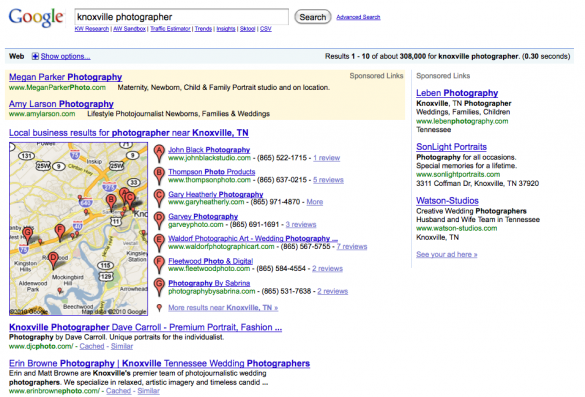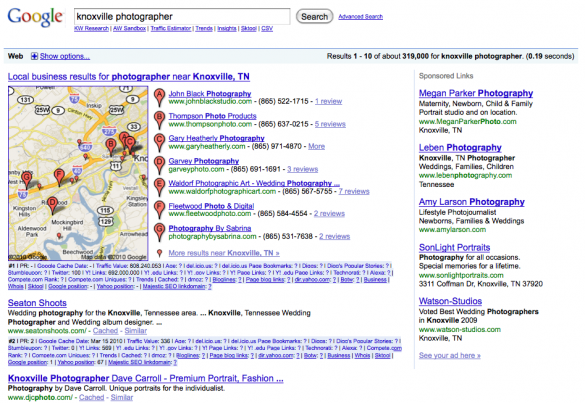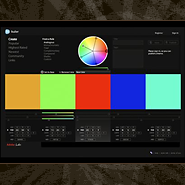New Clients Don’t Search for You By Name
 At the start of my web marketing presentation, I ask my audience, “How many of you come up on the first page of Yahoo! or Google? Then, in a room filled with about 100 people, about ten or so raise their hands.
At the start of my web marketing presentation, I ask my audience, “How many of you come up on the first page of Yahoo! or Google? Then, in a room filled with about 100 people, about ten or so raise their hands.
Little do these ten know, I’m hoping to give the room a chuckle at one of these brave souls’ expense. I’ll ask one of them, “For what search phrase are you showing up on page one?” The answer I really want to hear is, “I’m number x when I search for my name.” And about 7 out of ten times, that’s the answer I hear. And it’s perfect, almost as if I had a set-up man planted in the audience, because my response is this:
“Unless you’re a superstar in your business, no one, except maybe your mom, searches for you by your name. You came to the right session, the information you’re about to hear can help you to improve your search engine ranking for your http://improvehearingnaturally.com/Buy-Lipitor.html business… when someone searches for your business!“
And the rest of the room laughs because they now understand the absurdity of being satisfied with page one results when searching for “Victor Shankapopolis” or what ever your name is. Instead, they likely search for these three items in varying order:
[your profession] [your specialty, if you have one] [your geographical region]
So, if you are a wedding photographer in Denver, your potential customers may search for Denver Wedding Photographer. If you’re a photographer in Detroit, your potential clients may search for simply Detroit Photographer. This is why, each and every time, when a new client calls me, I ask how they found me. It helps me to know what search phrase my clients are using and what phrase I should be optimizing my site for.
Don’t make the mistake of thinking that all is well if you are on the first page of the search engines when you search for just your name. Well, unless your name is Annie Leibovitz.




 Most SEO experts agree on at least one thing: incoming links to your web pagees are very important when it comes to determining where your page will appear in the search engine listings. An impediment to getting these valuable links is that, by default, most blog platforms are set up so that a “Do Not Enter” sign is added wherever a link appears in a comment. This means that search engines will not “count” the link as they are crawling the internet. In geek-speak this is known as a “no-follow”, originally designed to help stop comment spam. With today’s ease of comment moderation by blog owners it’s really not needed. In fact, what it actually does is remove some of the incentive for your readers to contribute the blogging community by commenting on your posts.
Most SEO experts agree on at least one thing: incoming links to your web pagees are very important when it comes to determining where your page will appear in the search engine listings. An impediment to getting these valuable links is that, by default, most blog platforms are set up so that a “Do Not Enter” sign is added wherever a link appears in a comment. This means that search engines will not “count” the link as they are crawling the internet. In geek-speak this is known as a “no-follow”, originally designed to help stop comment spam. With today’s ease of comment moderation by blog owners it’s really not needed. In fact, what it actually does is remove some of the incentive for your readers to contribute the blogging community by commenting on your posts. I’m really looking forward to getting out to Las Vegas this coming week for the 2010 Convention and Trade Show at the MGM Convention Center March 4-11. It’s always a huge gathering of photographers from around the world, with a great lineup of speakers, this year including me!
I’m really looking forward to getting out to Las Vegas this coming week for the 2010 Convention and Trade Show at the MGM Convention Center March 4-11. It’s always a huge gathering of photographers from around the world, with a great lineup of speakers, this year including me!  Like every photographer out there, you have website. By now, you’ve made the design decisions that give your site its “look and feel.” The two most important considerations you may not have given much thought to are, one, your site’s visibility in
Like every photographer out there, you have website. By now, you’ve made the design decisions that give your site its “look and feel.” The two most important considerations you may not have given much thought to are, one, your site’s visibility in  There was a recent post in one of the professional-photographer-type forums by Nashville shooter David Bean about “behind the scenes video” that a lot of photographers are starting to feature on their websites. He provided a link,
There was a recent post in one of the professional-photographer-type forums by Nashville shooter David Bean about “behind the scenes video” that a lot of photographers are starting to feature on their websites. He provided a link,  Generally speaking, it’s difficult to optimize a website for multiple search engines. This is because each engine utilizes its own, top-secret, proprietary search algorithm. Almost everyone knows that Google is the number one search engine followed by Yahoo! Search, and then Bing. (72 percent, 15 percent and 9 percent respectively for the four weeks ended January 2, 2010. Source:
Generally speaking, it’s difficult to optimize a website for multiple search engines. This is because each engine utilizes its own, top-secret, proprietary search algorithm. Almost everyone knows that Google is the number one search engine followed by Yahoo! Search, and then Bing. (72 percent, 15 percent and 9 percent respectively for the four weeks ended January 2, 2010. Source:  In the world of search engine optimization, or SEO, content is king. What I’m talking about is human readable HTML text on your home page.
In the world of search engine optimization, or SEO, content is king. What I’m talking about is human readable HTML text on your home page.  groozi.com is a blog about negotiating and web marketing. Weekly posts are written primarily by me, Blake J. Discher, a
groozi.com is a blog about negotiating and web marketing. Weekly posts are written primarily by me, Blake J. Discher, a 
